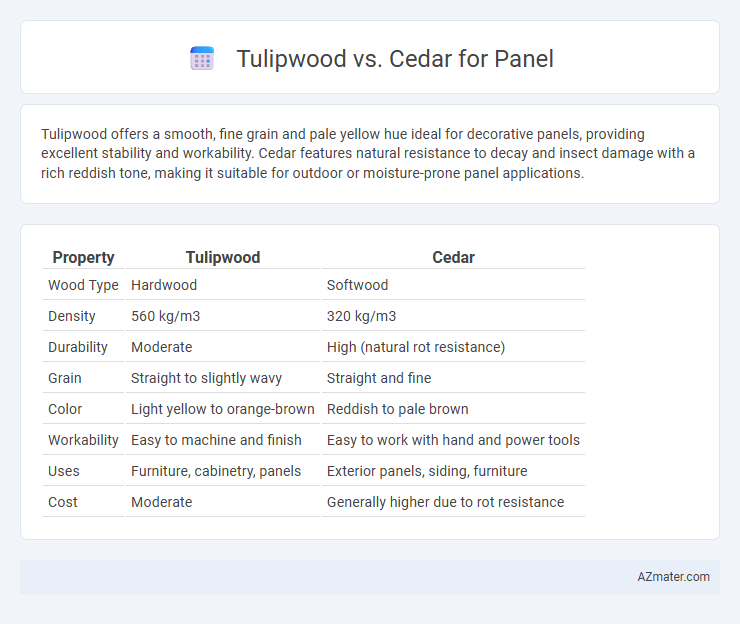Tulipwood offers a smooth, fine grain and pale yellow hue ideal for decorative panels, providing excellent stability and workability. Cedar features natural resistance to decay and insect damage with a rich reddish tone, making it suitable for outdoor or moisture-prone panel applications.
Table of Comparison
| Property | Tulipwood | Cedar |
|---|---|---|
| Wood Type | Hardwood | Softwood |
| Density | 560 kg/m3 | 320 kg/m3 |
| Durability | Moderate | High (natural rot resistance) |
| Grain | Straight to slightly wavy | Straight and fine |
| Color | Light yellow to orange-brown | Reddish to pale brown |
| Workability | Easy to machine and finish | Easy to work with hand and power tools |
| Uses | Furniture, cabinetry, panels | Exterior panels, siding, furniture |
| Cost | Moderate | Generally higher due to rot resistance |
Overview: Tulipwood vs Cedar for Panel Applications
Tulipwood offers a smooth, fine grain with a pale yellow to reddish-brown color, making it ideal for decorative panel applications requiring a consistent, elegant appearance. Cedar features natural oils that provide excellent resistance to moisture, decay, and insects, enhancing its durability for interior and exterior paneling. Both woods have distinct advantages: tulipwood excels in aesthetic appeal and ease of finishing, while cedar stands out for its longevity and weather-resistant properties.
Key Characteristics of Tulipwood Panels
Tulipwood panels are prized for their fine, straight grain and light pinkish-brown color, offering a smooth surface ideal for painting or finishing. This wood provides excellent dimensional stability and resistance to warping, making it suitable for interior paneling applications. Unlike cedar, tulipwood is less aromatic and dense, resulting in a lighter, more workable material with moderate durability.
Essential Features of Cedar Panels
Cedar panels offer natural resistance to moisture, decay, and insect damage, making them highly durable for both indoor and outdoor applications. The wood's aromatic properties also contribute to a fresh, pleasant environment while providing excellent thermal insulation and dimensional stability. Compared to tulipwood, cedar's lightweight nature and distinct grain patterns enhance aesthetic appeal and ease of installation in paneling projects.
Comparing Durability: Tulipwood and Cedar
Tulipwood offers moderate durability with good resistance to wear, making it suitable for interior paneling but requiring treatment for outdoor use. Cedar is naturally durable and highly resistant to rot and insect damage, making it an excellent choice for exterior panels and humid environments. When comparing durability, cedar outperforms tulipwood in longevity and weather resistance, especially in outdoor applications.
Resistance to Moisture and Decay
Tulipwood exhibits moderate resistance to moisture but tends to be less durable when exposed to prolonged damp conditions, making it susceptible to decay without proper sealing. Cedar offers superior natural resistance to moisture and decay due to its high content of natural oils and tannins, which inhibit fungal growth and rot. For panels exposed to humid or wet environments, cedar is often the preferred choice because of its longevity and minimal maintenance requirements.
Workability and Ease of Installation
Tulipwood offers excellent workability due to its fine, even grain and moderate hardness, allowing for smooth cutting, sanding, and shaping during panel installation. Cedar is also easy to work with, featuring a softer texture that reduces tool wear and simplifies fastening, but its tendency to splinter requires careful handling. Both woods provide favorable ease of installation, with tulipwood being preferred for precision applications and cedar valued for its lightweight and natural resistance to decay.
Sustainability and Environmental Impact
Tulipwood offers a sustainable option due to its fast-growing nature and efficient use in furniture and paneling, resulting in a lower carbon footprint compared to slower-growing hardwoods. Cedar is naturally resistant to decay and insects, reducing the need for chemical treatments and contributing to its environmental benefits, especially when sourced from certified sustainable forests. Both woods provide eco-friendly choices for paneling, but tulipwood's rapid renewability gives it a slight edge in minimizing environmental impact.
Cost Comparison: Tulipwood vs Cedar Panels
Tulipwood panels generally offer a more affordable option compared to cedar, with prices averaging 20-30% lower per square foot, making them budget-friendly for large projects. Cedar panels, prized for their natural resistance to decay and insect damage, typically command higher prices due to their durability and aesthetic appeal. When considering long-term value, tulipwood requires sealing and maintenance to prevent wear, while cedar's inherent properties can reduce maintenance costs despite the initial premium.
Aesthetics and Finishing Options
Tulipwood offers a smooth, fine-grained texture with a pale yellow to light pink hue, making it ideal for high-quality paneling applications that require a sleek, modern aesthetic. Cedar features a rich, reddish-brown color with prominent knots and a natural aromatic scent, providing a rustic and warm appearance that ages gracefully over time. Both woods accept stains and finishes well, but Tulipwood's uniform grain allows for a more consistent application of clear coats or paints, while Cedar's natural oils enhance durability and impart a weather-resistant finish ideal for both indoor and outdoor panels.
Best Uses: Choosing Between Tulipwood and Cedar for Paneling
Tulipwood offers a smooth texture and light color ideal for interior paneling, cabinetry, and furniture where a refined, modern appearance is desired. Cedar provides natural resistance to decay and insects, making it the best choice for exterior paneling, saunas, and moisture-prone areas requiring durability and aromatic qualities. Selecting between tulipwood and cedar depends on specific project needs such as indoor versus outdoor use, desired aesthetics, and environmental exposure.

Infographic: Tulipwood vs Cedar for Panel
 azmater.com
azmater.com